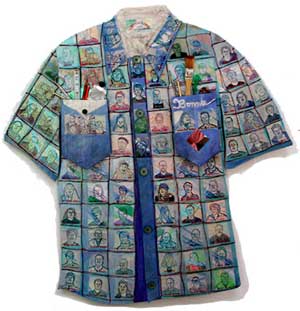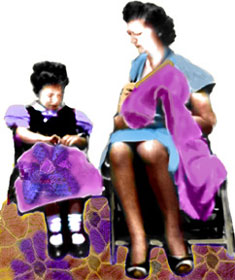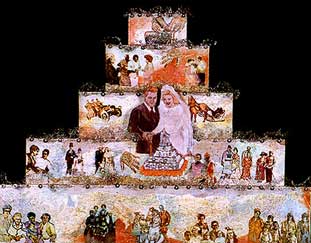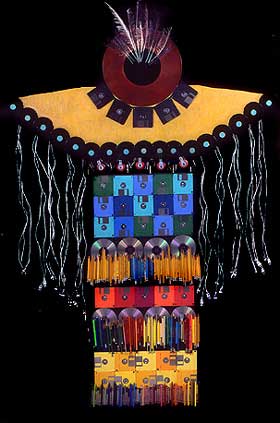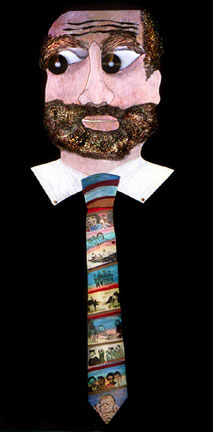|
||||||||||||||||
|
A
p r i l 2 0 0 5
|
||||||||||||||||

Sketch
Pad
Ties that bind
"As new materials become available to me I add them to my toolbox," she said. "Recycled computer parts and wire became part of that box in 1974, long before I even knew how to turn on a computer." Since '85, Bonnie has been using a Macintosh to design her art and, for more than a decade, she's added manipulated digital photography to the pieces. The crochet ties the disparate materials and techniques together with structure, transparency and pattern. "My goal is to use the materials and techniques that best express a particular idea and integrate them thoroughly into an artwork," she said. One of her recent devices for using mixed media is to make a wood armature for her crocheted figures or vases. The wood framework opens up possibilities for adding color and for screwing on found objects. "I started doing this because my hands didn't like crocheting all day," she said. "I needed to vary my activities. "What started as a way to save my hands forced me into a much more interesting way of working." Serendipity happens
"The journey is still incredibly interesting," she said. "I can hardly read one article online without doing a search on something within that article. "The Internet has validated how I think; one thought jumps to another and another until the last thought doesn't seem to have any relationship to the first, but the connecting thread is there." Bonnie's art doesn't always begin with a plan or idea. Sometimes she simply starts manipulating materials, layering computer parts and bits of crocheted wire on painted boards, screening or a metallic grid. "I like to let the serendipity happen," she said. "Sometimes the mind's eye fools me and I have to redo a part, but more often than not I plan things out using my best apprentice in my studio – my computer." Bonnie scans computer parts and other objects then puts them together using Photoshop. This is especially useful for her commissioned pieces. "I can shrink the resulting plan and place it in a photo of the room," she said. "I can enlarge the drawing, make a template for construction, then take the template to the client so they can see how it fits in the real room."
Border crossings
"Many times all the themes are wound into one piece just as the materials I use cross borders of categories," she said. Although some of her work is abstract, even those can incorporate themes from the materials she uses: namely, computer parts. "The very names of the computer parts are ripe for subject matter and metaphor," she said. "It's no accident that so many of my pieces have the word 'memory' in their titles." Taking shape "I grew up in the days when there were still art teachers in grade school," she said. "They all kept their eyes out for me, giving me art materials and taking me to New York to see museums, art schools and musicals." The encouragement Bonnie received from her teachers continued through college and graduate school. "Maybe it was the schools I went to or the particular grouping of individuals," she said, "but I didn't experience the put downs or shunning that many women artists my age experienced in school. "The caring treatment I received as a student has shaped me as a teacher."
Digital revolution "It was logical that I taught crocheting and other fiber techniques in the '70s, but then a career-changing event happened – I became an early adapter of technology," she said. That's when Bonnie bought a Macintosh and taught herself how to use it. After an article in the Oregonian told how Bonnie used her Mac to design an exhibit at the Children's Museum, she was asked to speak at a computer-education conference. Since then, Bonnie has gone to schools, conferences, colleges and
clubs to teach hands-on digital drawing and digital photography
to artists, teachers and children.
She also gave illustrated lectures on art and technology and how artists use computers to make their work and run their businesses. Her most popular class is still Ethics of Digital Photography. "Once you have the ability to change a photograph you have to ask yourself, 'Do I have permission?' and 'What are the consequences of changing this photo?' "I have great pictures from art, politics, journalism and advertising that illustrate the main points," she said. "I've been giving lectures on the subject for over a decade. In the early years people didn't even know what digital photography was. Now they're taking pictures with their phones." Light adventure "I'll spend two weeks working with 50 students using a Wacom drawing tablet and pen instead of a mouse, and some wonderful software that mimics the line quality you get from a variety of media, like chalk, oil, paint, pen or pencil," she said. Bonnie has taught both in village and small-city schools in Alaska. "It's always an adventure because life there is so different," she said. "A big difference is the light. It changes what you know about time and your perspective of things." Around the block
The idea to do the pieces like real quilts, but using screen and floppy disks rather than fabric, came about because inside the gallery is a national art-quilt exhibition. "It's a natural fit," she said. "However, because my work isn't geometric, I had to fit the geometric idiom into how I work – make it less rigid. To make this piece I played with the disks on a large table, then photographed each result. "It was just like a kid playing with blocks." For the second panel Bonnie used the disks, print-side up. She was well into the piece when she noticed the company name showing up along the edge. Every six inches was the word "Liberty." The title of the piece became "Liberty on the Edge." "I just can't resist making a piece political," she said.
Food for thought "I'm a long-time, organic gardener," she said. "I don't know what form the art will take but it will be a logical extension of what I do – that mixture of materials that will tell a story about growing our food." Long engagement "If the fates are good to me I'll continue to have more ideas for art than I can make," she said. "And new tools and techniques will pop up every so often and influence me." If you're a North Portland artist and want to be added to the Art on the Peninsula database, or if you'd like info on the annual Portland Open Studios in October, e-mail Bonnie. |
||||||||||||||||
|
E-mail Bonnie at bonnie@bonniemeltzer.com and visit her Web site. You can reach Kathy at kanderson138@comcast.net, and draw on other Sketch Pads. |
||||||||||||||||
|
|
||||||||||||||||
|
|




